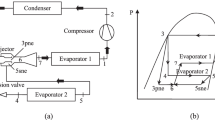Abstract
In this study, a modified ejector-expansion refrigeration cycle (MERC) is proposed for applications in small refrigeration units. A vapor bypass circuit is introduced into the standard ejector expansion refrigeration cycle (ERC) for increasing the ejector pressure lift ratio, thereby lowering the compressor pressure ratio in the MERC. A mathematical model has been established to evaluate the performances of MERC. Analysis results indicate that since a two phase vapor-liquid stream is used to drive the ejector in the MERC, a larger ejector pressure lift ratio can be achieved. Thus, the compressor pressure ratio decreases by 21.1% and the discharge temperature reduces from 93.6°C to 82.1°C at the evaporating temperature of -55°C when the vapor quality of two phase vapor-liquid stream increases from 0 to 0.2. In addition, the results show that the higher ejector component efficiencies are effective to reduce the compressor pressure ratio and the discharge temperature. Actually, the discharge temperature reduces from 91.4°C to 82.1°C with the ejector component efficiencies increasing from 0.75 to 0.85 at the two phase stream vapor quality of 0.2. Overall, the proposed cycle is found to be feasible in lower evaporating temperature cases.
Similar content being viewed by others
References
Sarkar J., Ejector enhanced vapor compression refrigeration and heat pump systems—A review. Renewable & Sustainable Energy Reviews, 2012, 16(9): 6647–6659.
Sumeru K., Nasution H., Ani F.N., A review on two-phase ejector as an expansion device in vapor compression refrigeration cycle. Renewable & Sustainable Energy Reviews, 2012, 16(7): 4927–4937.
Kim H.D., Lee J.H., Setoguchi T., Matsuo S., Computational analysis of a variable ejector flow. Journal of Thermal Science, 2006, 15: 140–145.
Kim H., Lee Y., Setoguchi T., Yu S., Numerical simulation of the supersonic flows in the second throat ejector-diffuser systems. Journal of Thermal Science, 1999, 8: 214–222.
Lawrence N., Elbel S., Theoretical and practical comparison of two-phase ejector refrigeration cycles including First and Second Law analysis. International Journal of Refrigeration, 2013, 36(4): 1220–1232.
Ersoy H.K., Sag N.B., Preliminary experimental results on the R134a refrigeration system using a two-phase ejector as an expander. International Journal of Refrigeration, 2014, 43: 97–110.
Li H.S., Cao F., Bu X.B., Wang L.B., Wang X.L., Performance characteristics of R1234yf ejector-expansion refrigeration cycle. Applied Energy, 2014, 121(15): 96–103.
Hassanain M., Elgendy E., Fatouh M., Ejector expansion refrigeration system: Ejector design and performance evaluation. International Journal of Refrigeration, 2015, 58: 1–13.
Sag N.B., Ersoy H.K., Hepbasli A., Halkaci H.S., Energetic and exergetic comparison of basic and ejector expander refrigeration systems operating under the same external conditions and cooling capacities. Energy Conversion and Management, 2015, 90(15): 184–194.
He Y., Deng J.Q., Zheng L.X., Zhang Z.X., Performance optimization of a transcritical CO2 refrigeration system using a controlled ejector. International Journal of Refrigeration, 2017, 75: 250–261.
Chen J.Y., Jarall S., Havtun H., Palm B., A review on versatile ejector applications in refrigeration systems. Renewable & Sustainable Energy Reviews, 2015, 49: 67–90.
Besagni G., Mereu R., Inzoli F., Ejector refrigeration: A comprehensive review. Renewable & Sustainable Energy Reviews, 2016, 53: 373–407.
Llopis R., Torrella E., Cabello R., Sánchez D., HCFC-22 replacement with drop-in and retrofit HFC refrigerants in a two-stage refrigeration plant for low temperature. International Journal of Refrigeration, 2012, 35(4): 810–816.
Park C., Lee H., Hwang Y., Radermacher R., Recent advances in vapor compression cycle technologies. International Journal of Refrigeration, 2015, 60: 118–134.
Jiang S., Wang S.G., Jin X., Yu Y., The role of optimum intermediate pressure in the design of two-stage vapor compression systems: A further investigation. International Journal of Refrigeration, 2016, 70: 57–70.
Tan Y., Chen Y., Wang L., Thermodynamic analysis of a mixed refrigerant ejector refrigeration cycle operating with two vapor-liquid separators. Journal of Thermal Science, 2018, 27(3): 230–240.
Keenan J.H., Neuman E.P., Lustwerk F., An investigation of ejector design by analysis and experiment. ASME Journal of Applied Mechanics, 1950, 72: 299–309.
Manjili F.E., Yavari M.A., Performance of a new two-stage multi-intercooling transcritical CO2 ejector refrigeration cycle. Applied Thermal Engineering, 2012, 40: 202–209.
Wang X., Yu J.L., Zhou M.L., Lv X.L., Comparative studies of ejector-expansion vapor compression refrigeration cycles for applications in domestic refrigerator-freezers. Energy, 2014, 70(1): 635–642.
Lucas C., Koehler J., Experimental investigation of the COP improvement of a refrigeration cycle by use of an ejector. International Journal of Refrigeration, 2012, 35(6): 1595–1603.
Brunin O., Feidt M., Hivet B., Comparison of the working domains of some compression heat pumps and a compression-absorption heat pump. International Journal of Refrigeration, 1997, 20(5): 308–318.
Lemmon E.W., Huber M.L., McLinden M.O., NIST Thermodynamic and Transport Properties of Refrigerants and Refrigerant Mixtures (REFPROP) Version 8.0. NIST, 2007.
Navarro E., Urchueguía J.F., Gonzálvez J., Corberán J.M., Test results of performance and oil circulation rate of commercial reciprocating compressors of different capacities working with propane (R290) as refrigerant. International Journal of Refrigeration, 2005, 28(6): 881–888.
Aroraa A., Kaushikb S.C., Theoretical analysis of a vapour compression refrigeration system with R502, R404A and R507A. International Journal of Refrigeration, 2008, 31(6): 998–1005.
Alexis G.K., Rogdakis E.D., A verification study of steam-ejector refrigeration model. Applied Thermal Engineering, 2003, 23(1): 29–36.
Sun D.W., Variable geometry ejectors and their applications in ejector refrigeration systems. Energy, 1996, 21(10): 919–929.
Vereda C., Ventas R., Lecuona A., Venegas M., Study of an ejector-absorption refrigeration cycle with an adaptable ejector nozzle for different working conditions. Applied Energy, 2012, 97: 305–312.
Elbel S., Hrnjak P., Experimental validation of a prototype ejector designed to reduce throttling losses encountered in transcritical R744 system operation. International Journal of Refrigeration, 2008, 31(3): 411–422.
Zheng L.X., Deng J.Q., Research on CO2 ejector component efficiencies by experiment measurement and distributed-parameter modeling. Energy Conversion and Management, 2017, 142(15): 244–256.
Acknowledgements
This research is funded by the National Natural Science Foundation of China (NSFC) No.51776147. The authors thank NSFC for the support.
Author information
Authors and Affiliations
Corresponding author
Rights and permissions
About this article
Cite this article
Li, Y., Yu, J. Thermodynamic Analysis of a Modified Ejector-Expansion Refrigeration Cycle with Hot Vapor Bypass. J. Therm. Sci. 28, 695–704 (2019). https://doi.org/10.1007/s11630-019-1124-6
Received:
Published:
Issue Date:
DOI: https://doi.org/10.1007/s11630-019-1124-6




